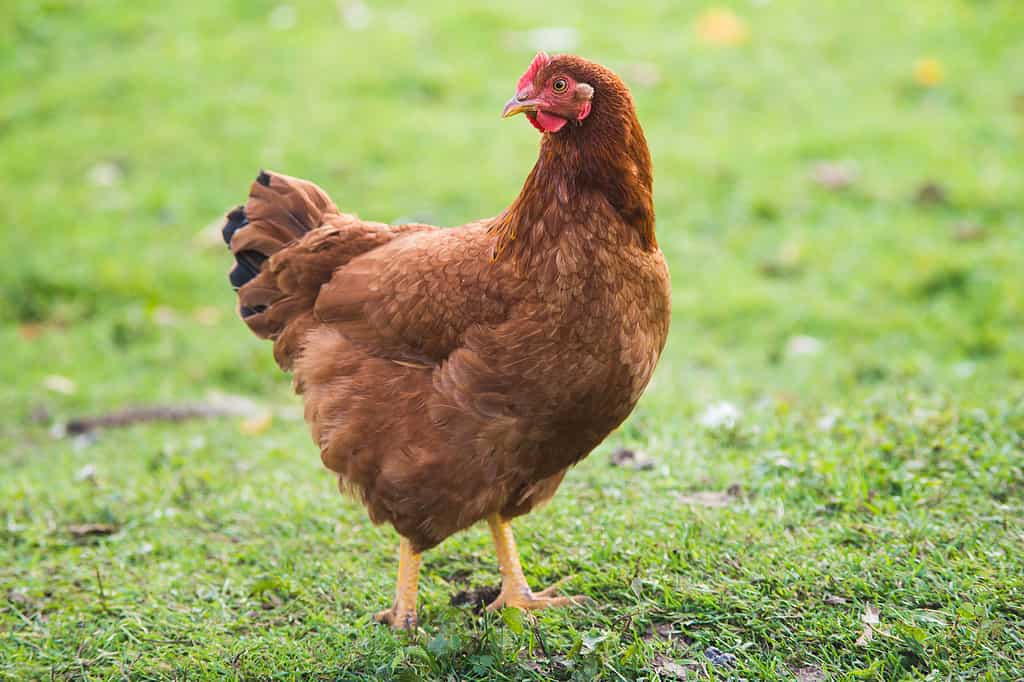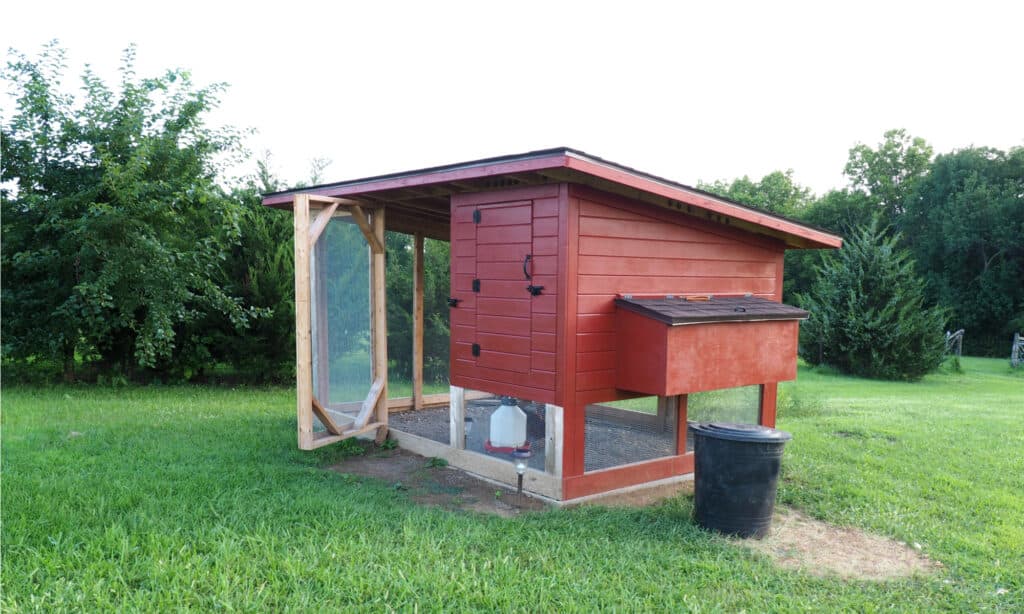Probably everyone out there has seen a Rhode Island Red chicken in real life, if not in film or television. These reddish-brown birds have earned the reputation for being low-maintenance, good producers, and friendly animals overall. They’re also one of the most affordable chickens to date, as there are a plethora available just about anywhere. But, before you invest in a small yard (or large!) full of animals, it’s always good to assess the costs. Today, we’ll be looking specifically at Rhode Island Red chicken costs per bird, set-up, and maintenance.
Breed Information

Rhode Island Red chickens are among the longest-living chicken breeds. They’re also friendly, good layers, and curious, making them great pets and backyard birds. Thankfully, they’re not terribly expensive, either.
©Nadanka/iStock via Getty Images
| Egg Color | Brown |
| Egg Size | Large |
| Egg Production | Excellent |
| Disposition | Hens: docile; roosters: may be aggressive |
| Hardiness | Cold & heat tolerant |
| Broody | No |
| Average Hen Weight | 6 1/2 pounds |
| Average Rooster Weight | 8 1/2 pounds |
Where Can You Buy Rhode Island Red Chickens?
The best place to find healthy chicks or full-grown birds is through a reputable hatchery. Many exist around the country, with reasonable access for small broods or large, depending on your needs. You may occasionally find good, healthy birds at a flea market, feed store, state fairs, auctions, and similar in your area. You may even find some online on occasion.
The best way to make sure you receive healthy birds is verify the hatchery or seller’s reputation via reviews and information. Look for an NPIP certificate (National Poultry Improvement Plan). Compare prices and options online with various shops and stores before buying, though, to make sure you get the best deal and healthier birds.
How Much Does a Rhode Island Red Chicken Cost?

Thankfully, Rhode Island Red chicken prices are far from the highest on the market. In fact, they’re some of the most affordable chickens you can bring home. Some factors will impact the price of the birds, of course, ranging from sex, age, and ancestry. The younger the bird, the cheaper it will be.
The highest Rhode Island Red chicken prices will be attached to nearly adult birds, soon ready to start laying. Aim to buy birds when they are 5 to 7 weeks old, as this means they are still young but established and not quite as expensive because their weight will be lower. Younger chicks, however, will be cheaper, often $2 to $5 each.
Rhode Island Red Prices for Hens

Rhode Island Red chickens are intelligent, curious, and companionable. They’re pretty good-looking, too! Be sure to make sure the ones you bring home are healthy, with shiny feathers, clear eyes, and bright red combs.
©Ariene Studio/Shutterstock.com
On average, an adolescent to adult Rhode Island Red hen will cost between $4 and $6 per pound, when purchased in person. If the birds are shipped, extra fees will be tacked on. Larger stores and hatcheries are also more likely to have lower prices than small, pedigreed farms. You’ll probably pay about $16 for a young hen up to $26 for fully grown birds.
Rhode Island Red Rooster Price
Prices vary for roosters, particularly based on your location and the season. In most cases, you’ll find roosters cost between $10 and $15 a pound. Since these birds average 8.5 pounds at full size, you could be paying as much as $105 per rooster. If you purchase online, shipping fees will add up, too. To save money while still having a rooster or two, buy young birds locally.
In most cases, you won’t want more than one or two roosters, if you want any at all. They can be a bit aggressive and not nearly as friendly as hens. If you do want roosters, you’ll need to make sure the coop is large enough to accommodate more than one flock, or, ideally, house the roosters separately. Beware that they will attempt to fertilize the eggs the hens lay, as well, unless they’re kept separate.
Costs Associated With Rhode Island Red Chickens
Of course, the purchase of the birds isn’t the only Rhode Island Red chicken cost. You have to factor in things like the chicken coop, feed, maintenance, bedding, and other equipment for their care. If you buy chicks, you’ll also have the costs of heat lamps and other devices to help them grow mature and strong before they start laying.
Chicken Coop

You can buy a pre-fab chicken coop for your Rhode Island Red chickens or make your own if you’re handy. Be sure to buy a good blueprint if you’re making one yourself, though. You can recycle pallet wood, metal roofing, or leftover building supplies.
©Cynthia Farmer/Shutterstock.com
Pre-made chicken coops are the easiest way to go, based on the number of birds you’re planning to keep. They typically run between $300 and $2000, though, so often are frowned upon by backyard keepers. The price varies, of course, largely by the size and quality of the coop.
If you’re handy, though, you could use scrap wood, sheet metal, or even fencing to create your coop for much less. Scrounge websites like Freecycle.org for pallet wood and leftover construction materials to save the most. Craigslist and OfferUp also often have offerings to make simple construction on small projects more affordable, but buy a chicken coop blueprint for the best results. You don’t wind up with something too small or hard to build.
Coop Maintenance
Throughout the lifetime of your chicken coop, some maintenance will be required. Specifically, at least twice a year, you’ll need to remove old bedding and clean the coop out completely. This will require some basic animal-safe cleaning products and new bedding. Most folks pay between $10 and $30 annually for these two needs.
Bedding
Chicken coops require bedding for a healthy, happy environment. A few options exist, providing you with choices you can decide on for your own preferences and the costs. Ideally, focus on a compostable option to help make your clean-up and life easier.
Wood Shavings
One option for chicken coop bedding for Rhode Island Red chickens is wood shavings. This type of bedding is probably the most commonly used these days. You need to make sure you go for larger chips, not the tiny ones, though, as the smaller chips create a lot of dust. Skip the sawdust as well for the same reasons.
To change bedding for the chicken coop, you’ll probably spend about $6 to $12 dollars each round.
Hemp
Some folks opt for hemp as an absorbent, less messy bedding material for chicken coops. This type is easily compostable, as well, so folks looking for that quality will probably land on this one. It’s a bit more expensive, though, running at about $40 for a 45-pound bale.
Straw
Another cheaper bedding option, and probably the second most common, is straw. This long-time preference is a little less popular than wood chips, but it’s still a great option for compostable bedding. Straw for bedding will usually run you between $5 and $10 per replacement.
Feed

Chickens require special feed from an early age, until they’re able to transition to adult feed. Rhode Island Red chicken costs for food are pretty cheap compared to other animals in most cases.
©iStock.com/Jennifer Chamblee
The main ongoing expense for your birds is their feed. Chicks up to 10 weeks old consume about 1 pound of chicken feed every week. Adults, however, eat about 1.5 pounds of feed each week. If you allow the chickens to forage for insects and worms, though, that amount should drop some.
Chicks should be given starter feed, which usually goes for $0.50 and $0.75 a pound. You can choose organic feed, as well, but that’s a bit more costly, many starting at $0.75 a pound.
Standard feed for adult Rhode Island Red chicken costs between $0.15 and $0.30 a pound, with organic feed closer to $0.60 a pound.
You can supplement chicken diets with cracked corn, as well, which runs closer to $0.20 a pound. They love this addition, as it helps satisfy their urge to peck for food.
Overall, per month, you’ll spend about $30 per month on feed for 5 adult chickens.
Feeders and Waterers
To make life easier, provide your chickens with a feeder. Aim for a heavy-duty feeder for the best, long-lasting use. These will cost about $50 to $70 each. You’ll also need a waterer, which will cost about $35.
Provide every 6 to 8 chickens with their own feeder and waterer to prevent dominant birds from overtaking food and water.
Healthcare
It’s rare that you’ll need medical care for your chickens, but occasionally, things happen. Mites may infest the coop. If so, they must be eradicated with either Permethrin or diatomaceous earth or your birds won’t lay anymore and the infection will spread.
Every so often, chickens catch a cold or ailment that needs medication. Protecting the birds initially against Marek’s disease, Newcastle bronchitis, fowl pox, and others is best done with immunizations before release into the rest of the flock.
Vaccines may cost anywhere from $12 to $110, though these vaccines cover many birds, not just the one.
Ways to Save on Rhode Island Red Chicken Costs

Rhode Island Red Chicken costs don’t have to be frightening. In fact, if you can build your own coop and opt for local birds, it won’t be that much overall to keep a few of these beautiful birds in the backyard.
©Ariene Studio/Shutterstock.com
While chickens are far from the most expensive pets to keep, having more than two or three can wind up being pretty pricey. A few tips for saving money on chicken care include:
- Let your chickens do some free roaming. They’ll find worms and insects and supplement their diets with natural, healthy alternatives. This will cut the cost of feed needed per bird. You will need an automatic door system if you do this, though, as you’ll need to prevent your birds from accidentally wandering away.
- Offer your birds a single, once-a-day treat as they grow and to help maintain their size and health. This will help with production and improve their health overall, meaning more eggs and fewer vet visits. If the birds get bigger than average, though, stop feeding them the treats.
- Avoid overfeeding the chickens. Put them on a feeding schedule that will help them get enough (but not too much!) to eat each day. This will save money on long-term health, of course, but also in the meantime preventing food wastage.
- Always make water available to your birds. This will help their health and lifespans.
- Keep the coop and hutch clean. Clean out droppings, old food, and debris regularly. This will keep the birds healthier.
- Shop around for high-quality chicken food and sign up for newsletters, discounts, and freebies. This will help keep your birds eating healthy while reducing your Rhode Island Red chicken costs overall.
The photo featured at the top of this post is © Nadanka/iStock via Getty Images
Thank you for reading! Have some feedback for us? Contact the AZ Animals editorial team.







